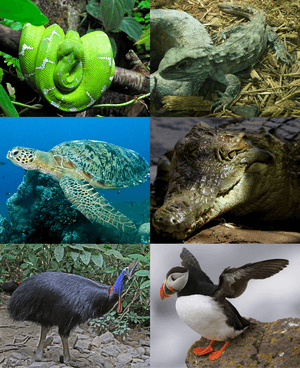Sauropsid facts for kids
Quick facts for kids Sauropsids |
|
|---|---|
 |
|
| Row 1: emerald tree boa and tuatara Row 2: green sea turtle and Nile crocodile Row 3: Southern cassowary and Atlantic puffin |
|
| Scientific classification | |
| Subgroups | |
Sauropsids are a group of land vertebrates which includes all existing reptiles and birds and their fossil ancestors. They are one of the two groups which evolved from egg-laying amniotes in the first part of the Carboniferous period.
The synapsids are the other group which evolved from amniotes. They gave rise, eventually, to the mammals.
Living sauropsids include lizards, snakes, turtles, crocodiles, and birds. Extinct sauropsids include dinosaurs, pterosaurs, plesiosaurs, ichthyosaurs, and many others.
Origin of tetrapods
More or less, the evolution of tetrapods has taken this course:
The earlies tetrapods lived in water. Clear fossil tetrapod tracks from the mid-Devonian predate previous tetrapod records by 18 million years.
Nine genera of Devonian tetrapods have been described. These earliest tetrapods were not terrestrial. They lived in swampy habitats like shallow wetlands, coastal lagoons, brackish river deltas, and even shallow marine sediments.
Romer's Gap
Between the lobe-finned fish tetrapods and the first amphibia and amniotes in the Middle Carboniferous lies a gap of 30 million years, with few satisfactory tetrapod fossils. This, noted in 1950, is Romer's Gap. Some new fossils were found in the 1990s, such as Pederpes, right in the middle of the Romer Gap. The gap still obscures the details of the tetrapod transition.
Sometime, in the later Devonian or earliest Carboniferous, the fishapods became mainly land-based. One group of them kept their link to the water, and always laid their eggs in water. They became the amphibians. The others evolved a way of laying eggs on land. They were the amniotes, whose key innovation was the cleidoic egg.
Sometime in the middle or lower Carboniferous, the amniotes split into two lines. One line lead to the reptiles of all kinds, and we call that the Sauropsida. The other line led eventually to the mammals, and we call that the Synapsida. It is not right to say "mammals evolved from reptiles" because both groups derived from early amniotes. In any event, modern reptiles are vastly different from modern mammals. Both groups have evolved for over 300 million years from the early amniotes.
Phylogeny
The cladogram presented here illustrates the "family tree" of sauropsids, and follows a simplified version of the relationships found by M.S. Lee, in 2013. All genetic studies have supported the hypothesis that turtles are diapsid reptiles; some have placed turtles within archosauromorphs, though a few have recovered turtles as lepidosauromorphs instead. The cladogram below used a combination of genetic (molecular) and fossil (morphological) data to obtain its results.
| Sauropsida |
|
|||||||||||||||||||||||||||||||||||||||||||||||||||||||||||||||||||||||||||||||||||||||||||||||||||||||||||||||||||||||||||||||||||||||||||||
Images for kids
-
The Berlin specimen of Archaeopteryx lithographica, a historically important fossil which helped to establish birds as a component of the reptile family tree
-
Mesozoic sauropsids: the dinosaurs Europasaurus and Iguanodon, and the early bird Archaeopteryx perched on the foreground tree stump.
See also
 In Spanish: Saurópsidos para niños
In Spanish: Saurópsidos para niños



